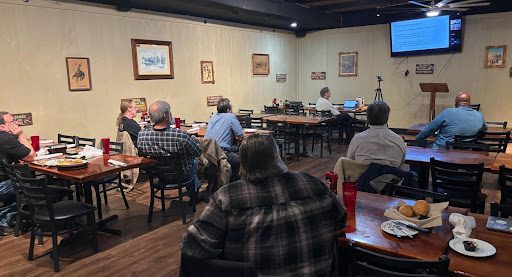IBM i User Groups have been the backbone of the midrange computing community for decades. As technology increasingly pushes us toward virtual interactions, local user groups remain vital for professional growth, networking, and knowledge sharing. Local technology User Groups (aka Regional User Groups, or RUGs) have been the social fabric of the technology community since the earliest days of computing. Perhaps you’ve heard of The Homebrew Computer Club of California, where Bill Gates and Steve Jobs were early members? It’s the place to swap ideas, show off achievements, build a network, and, most of all, build acquaintances and friendships with people with similar interests. Well, the IBM midrange community has been no different, and over the last 40 years, many fine clubs have risen and continue to thrive (even though others have closed their doors). In this humble author’s opinion, today’s networking landscape has (de)evolved to online forums and virtual meetings, and we need to go back to basics. Where’s the fun in staring at a screen at night that you’ve watched all day? I contend the core value of face-to-face networking remains unchanged, and it is worthy of you, dear reader of this article, to go and participate (or even start) your own Local Users Group!
Experiencing an IBM i User Group: One Evening in Nashville
I spent three hours on the evening of January 23rd at the Santa Fe Cattle Company in Nashville, Tennessee, at the monthly meeting of the IBM Midrange Users Group of Middle Tennessee – or IMUG for short. Did you know IMUG is the oldest continuously operating technology club in Tennessee? There are over 50 recorded presentations on the Members-Only portion of the website – what a membership benefit! IMUG has been meeting on the fourth Thursday of every month (except summers or the annual holiday party) for decades. Typical meetings range from 8 to 25 people, and on this particular evening, almost 30 people were registered. More than half of the audience chose to Zoom in this time, my guess because it was so cold outside. Conversations ranged from IBM i to hometowns to job searches. Drinks flowed (a few White Russians made their rounds), hot food was served (ribs, burgers, steak, salads), and the room was warm, cozy, and joyous.

The evening’s keynote speaker was Simon Hutchinson. He generously donated his private time to provide over 90 minutes of free, interactive training. No wonder he’s an IBM Champion! His presentation topics were “Simon’s Top 10 SQL Favorites” and “Tricks with Spool Files using SQL”. He demonstrated how to turn old spool files into PDFs and Excel spreadsheets with just a few SQL commands – a game-changer for report modernization.
This wasn’t a typical “everyone muted” webinar for questions to disappear into a chat void or even ignored, it was a discussion. Simon made everyone comfortable, creating an after-hours learning environment where no one felt strange speaking up.
The room lit up when he showed how to use the SQL Error Logging Facility (SELF) to capture and analyze SQL errors across an entire system, something that would have taken hours of manual debugging in the past.
Another participant leaned forward when Simon revealed how to use global variables in SQL to track and monitor system activities. This technique could solve a problem they’d been wrestling with for months. Other key takeaways included:
- The importance of moving from older tools like STRSQL to modern ones like ACS Run SQL Scripts,
- SQL’s efficiency advantages over traditional methods,
- The value of preview modes when deleting files and
- Tips for managing system resources like spool files.
Simon shared real-world examples of managing spool files, showing how to identify the largest and oldest files taking up space, and how to automate their cleanup – practical solutions that could free up system resources and save hours of administrative time. What made it special was people sharing their own experiences and challenges with these very issues, think of it like “bonding”!
Why In-Person IBM i User Groups Outperform Virtual Meetings
A local user group can be a great thing IF you help make it that way! The IBM i community provides rich support to local educational clubs, you just have to ask for it:
- Vendors love to present (educationally) on topics relevant to their expertise (ask Eradani for example – we love speaking about Integration and DevOps!)
- IBM is very generous with providing speakers about the platform, such as when Sarah Mackenzie spoke for Nashville about What’s New for DB2 for i, leading to a record turnout.
- Local user groups thrive on the authentic stories and experiences of your own community. Firsthand accounts are an opportunity for boldly open conversation; one legendary presentation in Nashville was a local Sys Admin at a healthcare company demonstrating his DR/HA strategy plusses and minuses.
COMMON dedicates space on its website to user groups and hosts dedicated get-togethers at its conferences for different groups to exchange ideas and share successes. It looks something like this:

😉 Think of your club as a bridge between generations and experience levels, from the college student’s first-time visit to “the guy who’s been working on this since the System 32 days” and loves to tell punch-card stories. Some LUGs (like LISUG and WMCPA) even partner with local universities to include computer science students anxious to participate, network, and get their first interview!
Did you know that a 2020 study in Nature found that creative idea generation decreased by about 20% in video meetings vs in-person brainstorming? And participants reported roughly 2x more mental fatigue after video meetings vs in-person meetings? Additionally, our friends at Microsoft found that meeting participants maintain focus for about 35-40 minutes in a video meeting compared to 50-55 minutes in an in-person meeting. “Video meeting fatigue” began to set in after 30-40 minutes versus 50-60 minutes for in-person meetings – people do better in person!
Finally, we must point out that this is an essential place for job hunting. I’ve seen attendees even bring their resumes, stand in front of the room, and announce their availability. IBM business partners, vendors, and local employers are all present, and everyone has their eyes and ears open for hiring and searching. I learned about where to search online (such as the all400s job boards) through gossip. A local company just added 65 Power 10 machines across the country and desperately needed Sys Admins. Club members whisper about private topics, like which company pays what salary and if a layoff is coming. There’s a trust to in-person discussions that just doesn’t happen over Teams!
How to Get Involved with IBM i User Groups: Your Next Steps
If you are in one of these US States, there is an active IBM i Users Group:
- California
- Connecticut
- Illinois
- Massachusetts
- Michigan
- Minnesota
- New Hampshire
- New York
- Ohio
- Tennessee
- Texas
- Toronto
- Virginia
- Wisconsin
If you don’t see your home state, reach out to me and I’ll connect you with the resources to start your own RUG!
Nashville’s IMUG didn’t just survive for decades, it’s thrived because it offers things that online forums and virtual meetings can’t replicate: genuine human connection, practical hands-on learning, vendor giveaways, the joy of an employer-neutral environment, stories, laughing, high-Calorie Desserts, and terrific company.

Mitch Hoffman, VP of Worldwide Sales, Eradani
Mitch Hoffman is the VP of Worldwide Sales and a co-founder of Eradani. With over 30 years in IT and 15 years of IBM i experience, he serves on the board of the Nashville IBM i Regional User Group and is a COMMON volunteer, demonstrating his commitment to the technology community. Reach out to us today to learn more!

